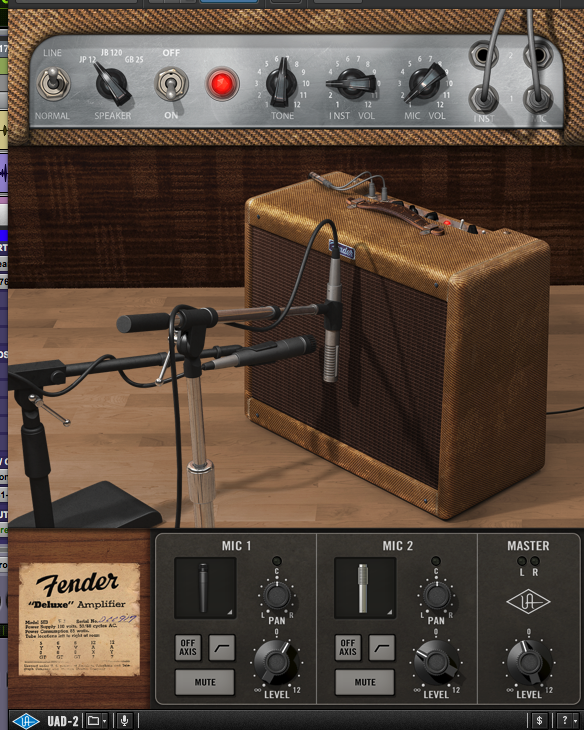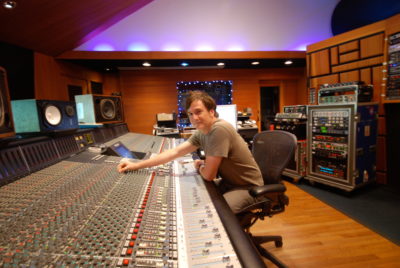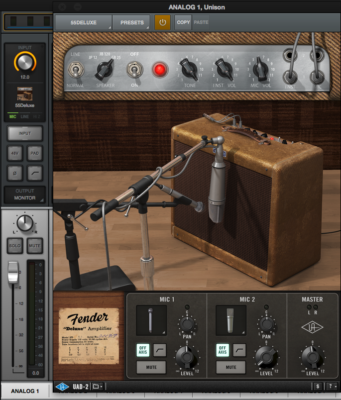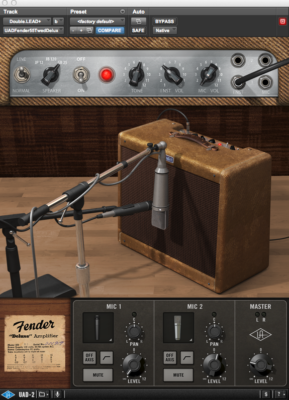3 Techniques: Universal Audio Fender ’55 Tweed Deluxe with Mixer Peter Mokran
Getting hands-on with the hardware. It’s one way to make the very most of software emulations.
When it comes to recreating amplifiers, that experience with the real thing becomes even more valuable. With their ability to move air all by themselves, amps aren’t just studio gear – they’re actual sources of sound.
Mixer/producer/engineer/musician Peter Mokran knows what it’s like to be in the room with real vintage Fender amplifiers. It’s all the better to get his “3 Techniques” on the Universal Audio Fender ’55 Tweed Deluxe plugin. An obsessive emulation of this prized amp’s 5E3 Deluxe circuit, it’s capable of producing extremely pleasing clean sounds, a sweet overdrive, and tube saturation-generated distortion that packs epic tone. Equally classic mic setups are available within, and the Unison technology on Apollo interfaces – Universal Audio’s analog/digital integration system – can be leveraged to really nail the ’55’s levels.
Guitars, vocals, drums and much more on in Mokran’s expert sights for this “3 Techniques.” With a galaxy of star credits in his mixing portfolio – from Ariana Grande to Prince to Hollywood feature films – let’s get enlightened by Mokran and his triple play.
Mixer Name: Peter Mokran
Mix facility name and location: Conway Studios, Hollywood CA
Select Credits: Ariana Grande, Christina Aguilera, Mary J. Blige, R. Kelly, The Flaming Lips, Camila, Michael Jackson, Prince,
Me as a Mixer: Every client is different, I like to use the hairstylist analogy; some people want a complete makeover, others just want a little off the top.
As an example, right now I’m working on the end title song for a Disney film. There are around 180 tracks; big live string section, horns, live drums, programmed drums, guitars, keyboards, female pop star singer, male R&B star singer, kitchen sink! My job is to make it all come together in a musical and commercial way, to somehow make it sound modern and classic at the same time.
I’m also working on mixes for the alternative band Somekindawonderful, where they built the music around their production, lots of one-time-only special reverbs and effects. In this case, I’m not reinventing anything, just enhancing what they’ve already done.
Finally I just got a track from producer Brandon Howard, his comment for the mix was, “Make it sound big, play some guitar parts, add a bass, and maybe program some additional drums”.
So I guess my philosophy is: Do whatever it takes.
My Go-To Plugin: I’ve used a real 50‘s Deluxe on some of my productions, so when I heard UAD were modeling one, I was very excited. There are so many amp plugins that do the thick super distorted pre amp sound, but the Deluxe really nails the crunchy power amp distortion.
They’ve done an outstanding job modeling it, it’s very touch sensitive and responds just like the real thing. You can roll back the volume on your guitar and find the perfect sweet spot, and it interacts really well with my favorite compressors and effects. I like the speaker and mic choice, and find myself switching between the stock fender and the Celestion greenback, depending on how it fits into the track. It has such a nice open sound, I even use it to add some grit to drums and vocals.
Technique #1 – Hit it at the Right Level: To really take advantage of the excellent dynamics of this plugin, you have to match the input level correctly. If you were to plug in a guitar with modern hot rodded pickups into a 1950’s amp, it will overload the input stage, so you have to roll back the volume a bit.
If you set the tone at 12 o’clock, you shouldn’t get any distortion until about 3 on the volume dial. The UAD unison technology input works really well with this. When I use it to reamp an existing track, or as an insert, I switch to Line input on the plugin, then clip gain the track to match the input level.
Technique #2 – So Good for Guitar: My go to crunchy rhythm sound is very Spinal Tap, Tone and Volume all the way up past 11 to 12!
Increasing the tone actually drives the amp harder. I then roll back the volume on the guitar to clean it up a bit. I insert the plugin in the Apollo preamp input unison slot. If I need more presence or brightness, I’ll set the virtual mics on axis. If I’m using a fatter guitar like a Les Paul, I’ll use more of the U67 mic. If I need less treble, I’ll use more of the mic volume, it’s a little duller, I like to mix a bit of it into the inst volume to thicken it up.
For a more vintage cleaner chimey sound, I switch to the JP12 speaker (the original speaker in the real amp), turn the tone back to around 5, and turn the volume down.
When I need more sustain for single note lines, I’ll plug in an overdrive pedal before the amp. It works really well with a real or virtual pedal. I really like the UAD modeled Tube Screamer, I set the tone around 11 O’clock and use just a bit of the overdrive control, be careful of the pedals level control. It’s so much like the real amp, I use basically the same settings and processing that I use with the real thing.
Technique #3 – Roughing up Vocals, Crunchy Drums: If I want to add some lively grit to a track, I like to use the Deluxe on a parallel aux track, and mix it back into the sound. This works well with drum overheads (screenshot at bottom) and vocals, or anything you want to rough up.
I like to use the JP-12 speaker for drums, it maintains clarity, I use the SM57 and Royer, if I want more low end, and more Kick drum, I’ll dial in more of the Royer mic. For a Nine Inch Nails distorted vocal, I like the Greenback speaker and the U-67. Set the switch to Line and you can use any setting on the volume to achieve the desired grit, even turned all the way up, it will still have clarity. Just make sure to turn down the master level as you turn up the amp volume.
Final W.O.W. (Words Of Wisdom): Whenever I use a plugin, I’m always aware of the gain structure.
If a compressor is boosting the signal, I make sure to turn down the output, this way I can accurately judge what the plugin is doing, and I’m not fooled by it being louder or quieter. I will also judge it in context of the mix, not just solo’d up, then I’ll A-B it against my current favorite to hear how it compares.

Drum overheads get nasty — in a nice way — with Mokran’s settings: the stock 1955 Jensen P12R speaker miked with an SM57 and a Royer on a parallel aux track, then mixed back in.










[…] 1 | 2 | Single […]